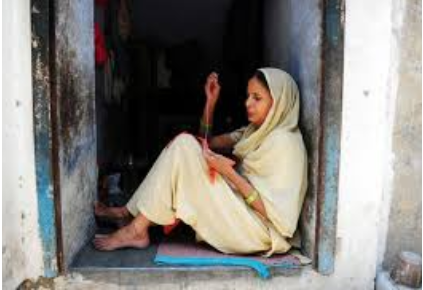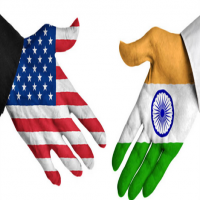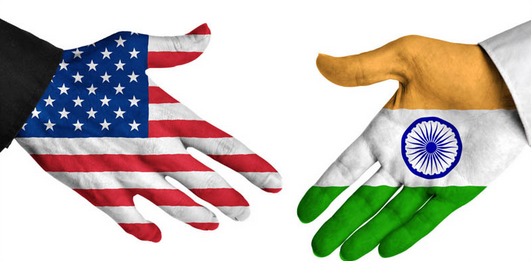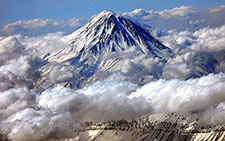INDO-US Relation from independent to the cold war
In the name of God
The Cold War (CW) paradigm started in 1947 and ended in 1991. So India at its independent’s year in 1947, faced with the CW paradigm immediately. Before that, when the Western and the Eastern blocs were engaged with a mutual struggle to defeating the Nazi regime in EU territories, the Indian revolutionary forces were combating on the United Kingdom colonizing over their homeland. The UK was one of the key icons in the Western bloc at that time; so as Jawaharlal Nehru mentioned in his book An Autobiography [A], the Indian revolutionary movement at that time were satisfied with the Germany’s victory over their colonizers; like British. Although Indian had no Pro-Nazism felling; but they were happy to see the defeating of their enemies in an Inter-Europeans fighting.
By the World War II (WWII), British was a superpower in the world and so many countries like India were under the UK control, these kinds of countries were ruling by a colonial system that arranged and managed by London; but as result of WWII, the British empire collapsed and the UK was downgraded to a second world-power level and it replaced by the USA after that. So although Indian was never faced with remarkable problem from the US side till that time, but they were very suspicious about the western bloc in general. Jawaharlal Nehru as first Prime Minister of India who were known as one of well-known world on-going trend at the time (independent era) who write a book in this regard, also in 1927 when he was reporting to the National Congress just 20 years before India Independent. Described The US as the great problem of India in near future:
“[The] great problem of the near future will be American imperialism, even more than British imperialism [B]”
He may perhaps could predict out-side India’s problem in near future but he didn’t aware of his party’s leaders in India National Congress who will prepared red carpet for this American Imperialism in 1990s to come to India and will stay solder to solder with them to make new world!! Look at Dr Manmohan Singh expression in Washington in 2006 when he said:
“India is today embarked on a journey inspired by many dreams. We welcome having America by our side. There is much we can accomplish together [C].”
But Indian leader who were ruling India after independent and during CW take distance of the Western bloc as well as the Eastern bloc, and they want to choose Non-Aligned policy toward the two blocs. Nehru chose a middle path, which subsequently came to be known as non-alignment. As early as 1947, in a note to India's Ambassador designate to China, K. P. S. Menon, he wrote:
“Our general policy is to avoid entanglement in power politics and not join any group of powers as against any other group. The two leading groups today are the Russian bloc and the Anglo-American bloc. We must be friendly to both and yet not join either. Both America and Russia are extraordinarily suspicious of each other as well as of other countries. This makes our path difficult and we may well be suspected by each of learning towards the other. This cannot be helped. … The Soviet Union, being our neighbor, we shall inevitably develop close relations with it. We cannot afford to antagonize Russia merely because we think that this may irritate someone else. Nor indeed can we antagonize the USA. [D]”
Indian took distance of the Western because of:
A) The UK as long-colonizer of India was one of the existed core element in the Western bloc.
B) Some of the main Indian revolutionary leaders like Jawaharlal Nehru and Gandhi… were UK-Educated persons and raised with the UK misunderstanding about Americans;
C) The US also had no history of relation with ancient India
D) During US Independent war also some of the British member involved who became the runner of the later the East Indian Company so as result there had no suitable relation between the East India Company and later British Raj and Independent-US.
E) After decolonizing also in some how this perspective generalized to the post colonial time and so as a result this lack of understanding were continue between them
F) US more reasonable relation with other Asian civilization like China and Japan coparceners with India was not accepted by Indian.
G) Some bad events that happened during colonial time for Indian in America cause a misunderstanding condition between the two countries after WWII also [E];
H) Setting India aside from the US core policy in Asia by choosing Pakistan in the US doctrine to encounter the Soviet Union (USSR) as the country which had serious war with India over Jammu & Kashmir region became US core alley so India for building a strategic balance in its Asian rivals took closed to USSR.
I) The causes of India rejecting to join any anti-Soviet coalition and the U.S. policy of seeking to achieve a strategic balance in South Asia and the latter ambition led the United States to extend large-scale economic and strategic assistance to Pakistan, in a sustained effort to develop it as a counterweight to India [F].
J) Anti-Imperialism felling among Indian leader in 1950s also made the two sides far away from being together.
K) The US Black & White positioning toward the others, was another factor that distanced them from the countries like India during CW and Iran now; the world players which want to exist independent; as some US policy-makers like Secretary of State John Foster Dulles declared “They who are not with us are against us” [F] or recently the US president George.W.Bush divided the world “with us or Against us” [] also that there was no middle in between.
L) And finally India by choosing socialism as her internal economy and politic system; attracted by the Eastern blocs
M) The USSR capturing central Asian countries became India’s neighbor in the north so India got closed to USSR during the CW era.
Although there was not an inimical situation between India and the USA; but they had no friendly relation also. India at that time tried to follow a middle way policy between the two blocs; key role of India in initiating the Non-Aligned Movement (NAM), which formed in early 1961s and at the same time closed and with an eye on the USSR policy in international battlefield was the character of India foreign policy. Hence it was some of the reasons that they take distance of the western bloc after the WWII.
Jawaharlal Nehru as a first Prime Minister and the architect of India's post-independence foreign policy ruled India within 1947 till 1964 and lead India in socialist bloc. He believes that socialism could help Indian to pass transitional period from a looted nation by colonizers with destroyed economy and disordered culture after near 3 centuries being under western invaders ruling. Although Indian had seen pressure of the escaped-US from colonial system’s president Franklin D. Roosevelt to giving independent to countries like India on the UK Prime Minister Winston Churchill in 1940s to give independent to India also; but emerging US as super power in middle 20th was not welcomed by India. Indian during CW had been using the USSR capacity in UNSC for encountering the US-backed Pakistani movement in international atmosphere. India and US in so many international main event like the Korean War and China membership in UNSC and the US Pro-Israeli positioning were opposite United State of America; but US humanitarian aid to India was considerable; for example during 1950 till 1965 50% of foreign aid belong to US. Although US had lost the best opportunity during 1962 Indo-Sino war, when India ask military assistant from the West and she didn’t received appropriate help; but Indo-US economic relation is also backed to 1960s and on the shadow of ups and downs in intergovernmental relation, was start and continue till now. At the time of separation of Bangladesh from Pakistan in 1971 the Indo-US relation came to lowest point and by its first nuclear test 1974 some sanctions imposed to India by US; The Mikhail Gorbachev coming to power in USSR and his changes and reform in the Soviet policies; led India to improve her relation with US during President Reagan (1980-8) and this trend started and it continue in Bush presidency (1988-92) and this time was the end of CW and there was no Soviet Union more and India even provided some logistic help to US military during the first Persian Gulf war in 1990; on the other hand based on this situation India’s reform in his economic regulation started and open a new era of cooperation between India and US; so India by adopting liberalizing process on the eve of collapsing the USSR is going to open her doors to the western capitals.
The Cold War era had strong effect on the South Asia strategic balance and the two superpower rivalry made Pakistan on the core position in US-policy and India also with the help of USSR renewed her military ability and both were armed with the nuclear bombs ability. The end of the Cold War caused a major shift in world politics and fundamentally restructured a number of relationships around the world, the India-US one being no exception.
Conclusion:
Indo-US division in somehow was the legacy of long centuries British colonizing; The UK membership in the West bloc as one of the important members after WWII and also American approach toward India and Pakistan during the CW. presentation of socialism in Nehru policy to transmit India from pre-colonial to post-colonial era, was another factor of Indo-US separation. About half century long CW started with anti-capitalism by Nehru and ended with being closeness to US by Manmohan Singh as architecture of new India that identifies India close to West. During the cold war also the US play with India and keep it in its process the lead it to open its market to capitalistic bloc.
References:
A) An Autobiography was written by Nehru during spending his time in colonizer’s jail and he described independent struggle process.
B) Jawaharlal Nehru, "Report to the all-India congress committee on the international congress against imperialism held at Brussels in February 1927," in Bimla Prasad, The Origins of Indian Foreign Policy: The Indian National Congress and World Affairs, 1885- 1947 (Mumbai: Bookland, 1960), appendix I, 265
C) Manmohan Singh, "Address to the joint session of the United States congress," Washington, DC, 19 July 2005," reproduced in Seminar 560, April 2006.
D) India-US Relations in a Changing Strategic Environment - Dr Ravi Tomar - Research Paper no.20 2001-2002-http://www.aph.gov.au/About_Parliament/Parliamentary_Departments/Parliamentary_Library/pubs/rp/rp0102/02RP20
E) Article “INDO-AMERICAN RELATIONS IN A NEW LIGHT” Dr. Madan Lal Goel - University of West Florida- Delivered at the Annual Meeting of the Indian Association of American Studies, 1999. Revised
F) U.S.-India Initiative Series - The Strategic Implications of Indo-U.S. Private-Sector Ties - By Rajiv Kumar (the
G) Director general of the Federation of Indian Chambers of Commerce and industry)
H) Quoted in Angadipuram Appadorai and M.S. Rajan, India's Foreign Policy and Relations (New Delhi: South Asian Publishers, 1985), 216.
Seyed Mostafa Mostafavi
M.A Student in The Subcontinent Studies
Faculty of world Studies
University of Tehran
For the subject “Indian Foreign Policy”
by Dr. Mandana Tishehyar
+ نوشته شده در سه شنبه هفتم آبان ۱۳۹۲ ساعت 13:11 شماره پست: 343









